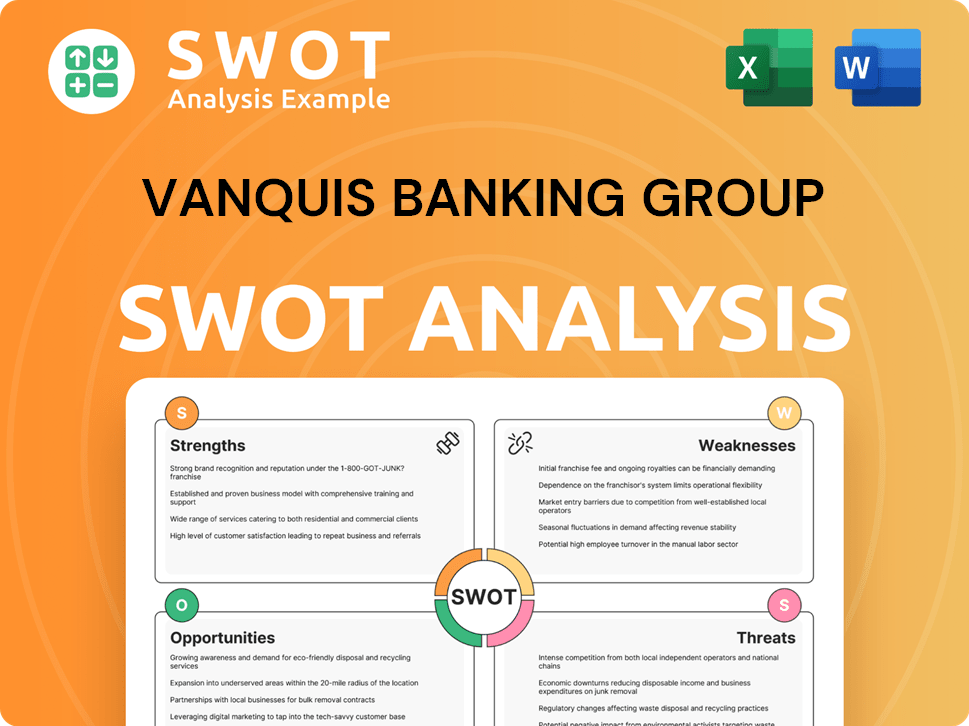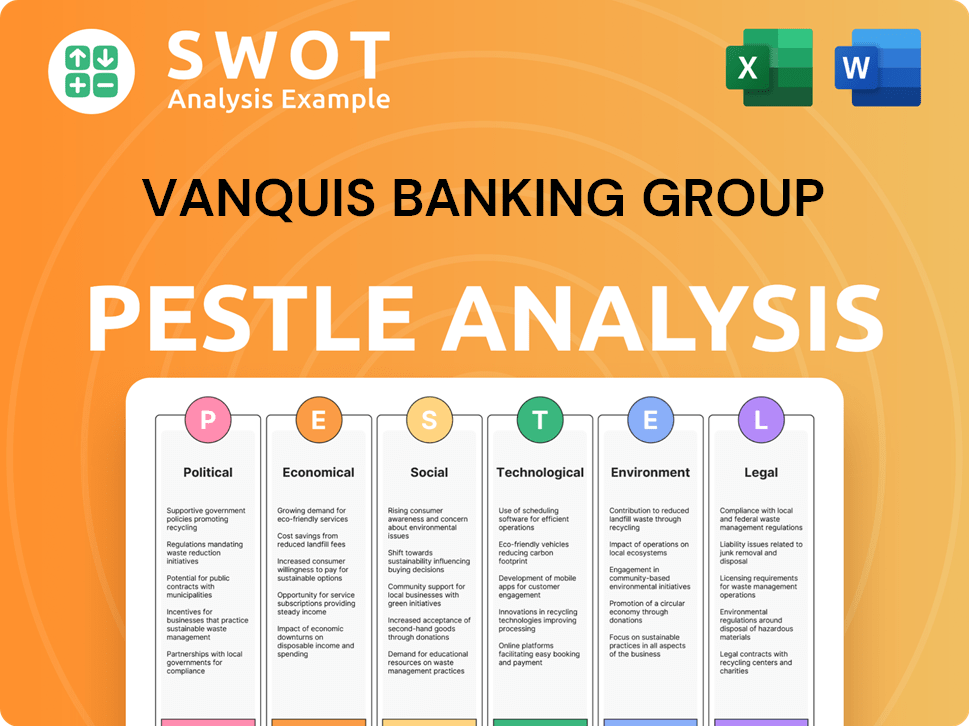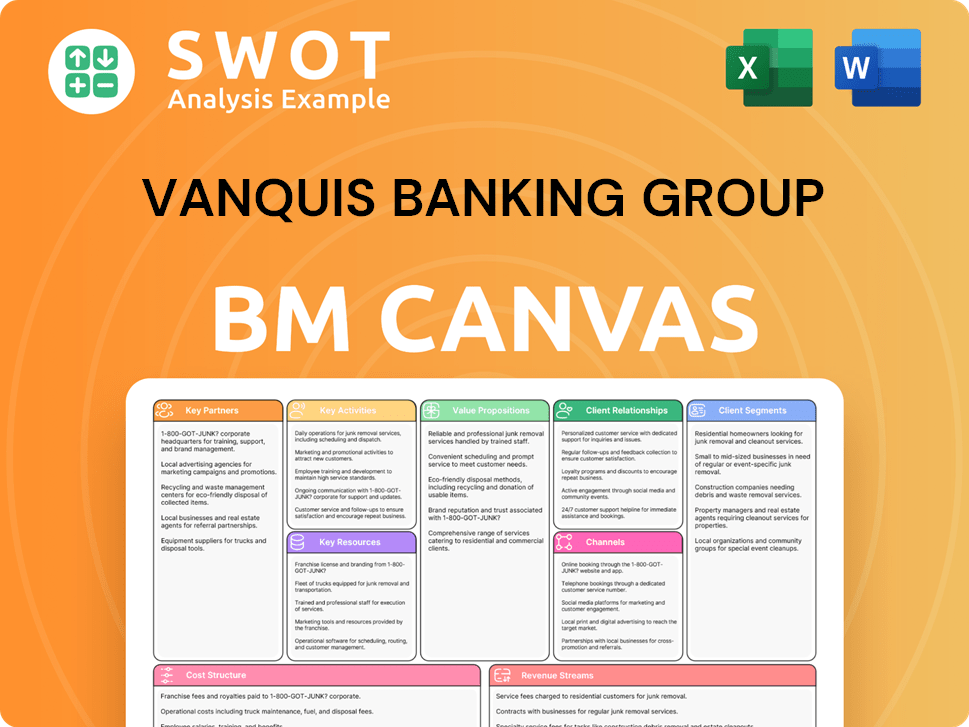Vanquis Banking Group Bundle
Who Really Owns Vanquis Banking Group?
Understanding the ownership structure of Vanquis Banking Group, formerly known as Provident Financial plc, is crucial for investors and stakeholders alike. This specialist bank, serving underserved customers in the UK and Ireland, has undergone significant evolution since its founding in 1880. Knowing who controls Vanquis Banking Group SWOT Analysis is key to understanding its strategic direction and future prospects.

From its roots as a doorstep lender to its current status as a publicly traded company, the evolution of Vanquis ownership reflects its changing business model. This analysis will explore the key players in Vanquis ownership, including major shareholders, and examine how these stakeholders influence the company's decisions. Discover the answers to questions like: Who are the major Vanquis shareholders and is Vanquis a public company? This deep dive into Vanquis Financial will provide valuable insights into its corporate governance and financial performance.
Who Founded Vanquis Banking Group?
The story of Vanquis Banking Group begins in 1880, in Bradford, England. Joshua Kelley Waddilove, an insurance agent and preacher, established The Provident Clothing and Supply Company, which would later evolve into the modern financial institution. Waddilove's vision stemmed from observing the financial hardships of working-class families, leading him to create a system to provide access to essential goods.
Waddilove's innovative voucher system allowed families to acquire items like clothing and food from local shops. These purchases were then repaid in small, manageable weekly installments, a pioneering approach to providing credit. This model laid the foundation for the company's early operations, focusing on serving those often overlooked by traditional financial institutions. The company's mission was to provide financial services to those who were underserved.
While specific details about Waddilove's initial equity or shareholding percentages are not publicly available, his role as the founder was central to the company's ownership structure. The business expanded, employing agents to assist with repayments, reflecting an early growth strategy. The company transitioned from a private, family-run enterprise to a public entity when it was listed on the London Stock Exchange on March 16, 1962, under the new name of Provident Financial plc, which is now known as Vanquis Financial. This change marked a shift from founder-led ownership to a wider base of public shareholders.
The early ownership of Vanquis Banking Group, initially The Provident Clothing and Supply Company, was primarily rooted in Joshua Kelley Waddilove's vision. The company's evolution from a voucher-based system to a publicly listed entity, Provident Financial plc, on the London Stock Exchange in 1962, marked a significant change in its ownership structure. This transition broadened the shareholder base from the founder to include public investors. The shift to a public company opened up new avenues for capital and growth, allowing Vanquis to expand its services and reach a wider customer base. This expansion is further detailed in Growth Strategy of Vanquis Banking Group.
- 1880: Joshua Kelley Waddilove founded The Provident Clothing and Supply Company.
- 1962: The company went public on the London Stock Exchange as Provident Financial plc.
- The initial focus was on providing credit to underserved working-class families.
- The company has evolved into a significant player in the financial services sector, offering various financial products, including Vanquis credit cards.
Vanquis Banking Group SWOT Analysis
- Complete SWOT Breakdown
- Fully Customizable
- Editable in Excel & Word
- Professional Formatting
- Investor-Ready Format

How Has Vanquis Banking Group’s Ownership Changed Over Time?
The ownership of Vanquis Banking Group (formerly Provident Financial plc) has evolved significantly since its initial public offering on March 16, 1962. As a publicly traded entity on the London Stock Exchange (LSE: VANQ), its ownership is spread across various institutional investors, mutual funds, and individual shareholders. The company's strategic decisions, such as exiting the doorstep lending market in 2021 and rebranding to Vanquis Banking Group in March 2023, have influenced its investor base and strategic direction. The acquisition of Moneybarn in 2014 also represented a key inflection point in its business strategy.
As of June 2025, the market capitalization of Vanquis Banking Group is approximately £0.24 billion. The company's shift to focus on the mid-cost credit market and its existing bank, Vanquis, reflects its evolving strategy and commitment to serving underserved customers. The Vanquis ownership structure is primarily influenced by institutional investors who hold a significant portion of the shares.
| Shareholder | Percentage of Shares (as of) | Notes |
|---|---|---|
| Schroder Investment Management Ltd. | 18.11% (March 31, 2025) | Major Institutional Shareholder |
| Redwood Capital Management LLC | 17.49% (February 28, 2025) | Significant Investor |
| Artemis Investment Management LLP | 9.97% (February 28, 2025) | Institutional Investor |
| Norges Bank Investment Management | 6.65% (February 28, 2025) | Institutional Investor |
| Davidson Kempner Capital Management LP | 4.91% (May 13, 2024) | Institutional Investor |
The current Vanquis shareholders include major institutional investors, with Schroder Investment Management Ltd. and Redwood Capital Management LLC holding the largest stakes. As of May 14, 2025, the share price of Vanquis Banking Group plc was 75.20 GBX per share, with a market cap of 179.33 GBX million. Understanding the Vanquis Financial landscape is crucial for investors. For more detailed information, you can find additional insights in a comprehensive analysis of the company's performance and strategic direction from a related article.
The ownership of Vanquis Banking Group is primarily held by institutional investors, reflecting its status as a publicly traded company.
- Schroder Investment Management Ltd. and Redwood Capital Management LLC are among the largest shareholders.
- The company's strategic decisions have influenced its investor base and market capitalization.
- Understanding the shareholder structure is vital for assessing the company's financial health and future prospects.
- The share price as of May 14, 2025, was 75.20 GBX.
Vanquis Banking Group PESTLE Analysis
- Covers All 6 PESTLE Categories
- No Research Needed – Save Hours of Work
- Built by Experts, Trusted by Consultants
- Instant Download, Ready to Use
- 100% Editable, Fully Customizable

Who Sits on Vanquis Banking Group’s Board?
The Board of Directors of Vanquis Banking Group (Vanquis PLC) oversees the company's strategic direction and governance. Key figures include Ian McLaughlin as CEO and Sir Peter Estlin as Chairman. Other members include Dave Watts, the Chief Financial Officer, along with Non-Executive Directors Oliver Laird and Graham Lindsay. The board's composition reflects a mix of executive and independent directors, aiming for a balance of expertise and oversight.
Director dealings are reported, offering insights into shareholdings and transactions. For instance, Dave Watts, the CFO, has been actively purchasing company shares. Sir Peter Estlin holds 300,000 shares, and Ian McLaughlin holds 1,768,493 shares. The percentage ownership for both is listed as 0.00% due to the large number of shares in issue. This information is crucial for understanding the alignment of interests between the board and Vanquis shareholders.
| Director | Position | Shareholding |
|---|---|---|
| Ian McLaughlin | CEO | 1,768,493 shares |
| Sir Peter Estlin | Chairman | 300,000 shares |
| Dave Watts | CFO | Ongoing purchases |
The voting structure at Vanquis Banking Group, a publicly listed company, follows a one-share-one-vote principle. This structure is standard for companies listed on the London Stock Exchange. There are no known special voting rights or founder shares that would give disproportionate control to specific entities. Shareholders can engage with the company through Annual General Meetings (AGMs), such as the one held on May 14, 2025. Institutional shareholders hold a significant portion of the outstanding shares, ensuring robust governance. To learn more about the company's financial aspects, you can review Revenue Streams & Business Model of Vanquis Banking Group.
The Board of Directors, including the CEO and Chairman, manages Vanquis Banking Group. The company's voting structure is straightforward: one share equals one vote. Institutional shareholders play a significant role in the company's governance.
- The board includes both executive and non-executive directors.
- Shareholder engagement occurs through AGMs.
- Institutional investors hold a substantial portion of shares.
- The company operates under standard voting rules.
Vanquis Banking Group Business Model Canvas
- Complete 9-Block Business Model Canvas
- Effortlessly Communicate Your Business Strategy
- Investor-Ready BMC Format
- 100% Editable and Customizable
- Clear and Structured Layout

What Recent Changes Have Shaped Vanquis Banking Group’s Ownership Landscape?
In recent years, Vanquis Banking Group has undergone significant strategic shifts, influencing its ownership landscape. A key move was the rebranding from Provident Financial plc in March 2023, reflecting a focus on the mid-cost credit market, particularly with its existing Vanquis Bank. This followed the closure of its doorstep lending business in December 2021. These changes highlight the company's adaptation to the financial market and its strategic repositioning.
Financially, 2024 was a 'pivotal year' for the company. Despite reporting a pretax loss of £136.3 million in 2024, compared to £12.0 million in 2023, due to a goodwill write-off and increased impairment charges, the company made substantial progress in its transformation. This included achieving over £64 million in cost savings by the end of 2024, exceeding its £60 million target, and anticipating an additional £15 million in savings by the end of 2025. The group returned to profitability in the first quarter of 2025, with gross customer interest-earning balances increasing by 1.8% to £2.3 billion. These financial developments are crucial for understanding the current
| Metric | Value | Year |
|---|---|---|
| Pretax Loss | £136.3 million | 2024 |
| Cost Savings Achieved | Over £64 million | End of 2024 |
| Gross Customer Balances | £2.3 billion | Q1 2025 |
| Share Price Increase (week prior to May 14, 2025) | 12.91% | May 2025 |
Ownership trends show continued significant institutional holdings. As of early 2025, Schroder Investment Management Ltd. and Redwood Capital Management LLC remained among the largest institutional shareholders. The company's share price saw a notable increase of 12.91% in the week prior to May 14, 2025, with its market cap reaching £179.33 million GBX. Analysts have reiterated ratings for the stock, with some raising price targets following stronger financial performance. The company aims to achieve a low single-digit return on tangible equity (ROTE) in 2025, with a target of mid-teens ROTE by 2027, driven by sustainable income growth and efficiency improvements.
The ownership of
The company’s share price increased by 12.91% in the week leading up to May 14, 2025. This indicates positive investor sentiment and confidence in the company's strategy.
The company aims for a low single-digit return on tangible equity (ROTE) in 2025. The target is to achieve mid-teens ROTE by 2027 through income growth.
The group is focused on the mid-cost credit market with Vanquis Bank. Cost savings and efficiency improvements are central to its transformation plan.
Vanquis Banking Group Porter's Five Forces Analysis
- Covers All 5 Competitive Forces in Detail
- Structured for Consultants, Students, and Founders
- 100% Editable in Microsoft Word & Excel
- Instant Digital Download – Use Immediately
- Compatible with Mac & PC – Fully Unlocked

Related Blogs
- What are Mission Vision & Core Values of Vanquis Banking Group Company?
- What is Competitive Landscape of Vanquis Banking Group Company?
- What is Growth Strategy and Future Prospects of Vanquis Banking Group Company?
- How Does Vanquis Banking Group Company Work?
- What is Sales and Marketing Strategy of Vanquis Banking Group Company?
- What is Brief History of Vanquis Banking Group Company?
- What is Customer Demographics and Target Market of Vanquis Banking Group Company?
Disclaimer
All information, articles, and product details provided on this website are for general informational and educational purposes only. We do not claim any ownership over, nor do we intend to infringe upon, any trademarks, copyrights, logos, brand names, or other intellectual property mentioned or depicted on this site. Such intellectual property remains the property of its respective owners, and any references here are made solely for identification or informational purposes, without implying any affiliation, endorsement, or partnership.
We make no representations or warranties, express or implied, regarding the accuracy, completeness, or suitability of any content or products presented. Nothing on this website should be construed as legal, tax, investment, financial, medical, or other professional advice. In addition, no part of this site—including articles or product references—constitutes a solicitation, recommendation, endorsement, advertisement, or offer to buy or sell any securities, franchises, or other financial instruments, particularly in jurisdictions where such activity would be unlawful.
All content is of a general nature and may not address the specific circumstances of any individual or entity. It is not a substitute for professional advice or services. Any actions you take based on the information provided here are strictly at your own risk. You accept full responsibility for any decisions or outcomes arising from your use of this website and agree to release us from any liability in connection with your use of, or reliance upon, the content or products found herein.